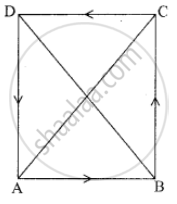Advertisements
Advertisements
Question
Using vector method, prove that if the diagonals of a parallelogram are equal, then it is a rectangle
Solution

Let ABCD be a parallelogram
To prove ABCD be a rectangle provided the diagonals are equal.
Now `bar"AC" = bar"AB" + bar"BC"`
`bar"BD" = bar"BC" + bar"CD"`
= `bar"BC" - bar"AB"`
But `(bar"AC")^2 = (bar"BD")^2`
`(bar"AB" + bar"BC")^2 = (bar"BC" - bar"AB")^2`
`(bar"AB")^2 + (bar"BC")^2 + 2bar"AB" * bar"BC" = (bar"BC")^2 + (bar"AB")^2 - 2bar"AB" * bar"BC"`
`4bar"AB" * bar"BC"` = 0
`bar"AB" * bar"BC"` = 0
`vec"AB"` ⊥r to `vec"BC"`
⇒ ABCD is a rectangle.
APPEARS IN
RELATED QUESTIONS
Prove by vector method that if a line is drawn from the centre of a circle to the midpoint of a chord, then the line is perpendicular to the chord
Prove by vector method that the area of the quadrilateral ABCD having diagonals AC and BD is `1/2 |bar"AC" xx bar"BD"|`
Prove by vector method that the parallelograms on the same base and between the same parallels are equal in area
If G is the centroid of a ΔABC, prove that (area of ΔGAB) = (area of ΔGBC) = (area of ΔGCA) = `1/3` (area of ΔABC)
Using vector method, prove that cos(α – β) = cos α cos β + sin α sin β
Prove by vector method that sin(α + ß) = sin α cos ß + cos α sin ß
A particle acted on by constant forces `8hat"i" + 2hat"j" - 6hat"k"` and `6hat"i" + 2hat"j" - 2hat"k"` is displaced from the point (1, 2, 3) to the point (5, 4, 1). Find the total work done by the forces
Forces of magnitudes `5sqrt(2)` and `10sqrt(2)` units acting in the directions `3hat"i" + 4hat"j" + 5hat"k"` and `10hat"i" + 6hat"j" - 8hat"k"` respectively, act on a particle which is displaced from the point with position vector `4hat"i" - 3hat"j" - 2hat"k"` to the point with position vector `6hat"i" + hat"j" - 3hat"k"`. Find the work done by the forces
Find the magnitude and direction cosines of the torque of a force represented by `3hat"i" + 4hat"j" - 5hat"k"` about the point with position vector `2hat"i" - 3hat"j" + 4hat"k"` acting through a point whose position vector is `4hat"i" + 2hat"j" - 3hat"k"`
Find the torque of the resultant of the three forces represented by `- 3hat"i" + 6hat"j" - 3hat"k", 4hat"i" - 10hat"j" + 12hat"k"` and `4hat"i" + 7hat"j"` acting at the point with position vector `8hat"i" - 6hat"j" - 4hat"k"` about the point with position vector `18hat"i" + 3hat"j" - 9hat"k"`
Choose the correct alternative:
If `vec"a"*vec"b" = vec"b"*vec"c" = vec"c"*vec"a"` = 0, then the value of `[vec"a", vec"b", vec"c"]` is
Let `veca = αhati + 3hatj - hatk, vecb = 3hati - βhatj + 4hatk` and `vecc = hati + 2hatj - 2hatk` where α, β ∈ R, be three vectors. If the projection of a `veca` on `vecc` is `10/3` and `vecb xx vecc = -6hati + 10hatj + 7hatk`, then the value of α + β is equal to ______.
Let A, B, C be three points whose position vectors respectively are
`vec"a" = hat"i" + 4hat"j" + 3hat"k"`
`vec"b" = 2hat"i" + αhat"j" + 4hat"k", α ∈ "R"`
`vec"c" = 3hat"i" - 2hat"j" + 5hat"k"`
If α is the smallest positive integer for which `vec"a", vec"b", vec"c"` are noncollinear, then the length of the median, in ΔABC, through A is ______.
Let `veca = hati - 2hatj + 3hatk, vecb = hati + hatj + hatk` and `vecc` be a vector such that `veca + (vecb xx vecc) = vec0` and `vecb.vecc` = 5. Then, the value of `3(vecc.veca)` is equal to ______.
Let `veca, vecb, vecc` be three mutually perpendicular vectors of the same magnitude and equally inclined at an angle θ, with the vector `veca + vecb + vecc`. Then, 36 cos22θ is equal to ______.
Let `veca, vecb` and `vecc` be three unit vectors such that `|veca - vecb|^2 + |veca - vecc|^2` = 8. Then find the value of `|veca + 2vecb|^2 + |veca + 2vecc|^2`
The vector `vecp` perpendicular to the vectors `veca = 2hati + 3hatj - hatk` and `vecb = hati - 2hatj + 3hatk` and satisfying the condition `vecp.(2hati - hatj + hatk)` = –6 is ______.
Let a, b, c ∈ R be such that a2 + b2 + c2 = 1. If `a cos θ = b cos(θ + (2π)/3) = c cos(θ + (4π)/3)`, where θ = `π/9`, then the angle between the vectors `ahati + bhatj + chatk` and `bhati + chatj + ahatk` is ______.
If `vecx` and `vecy` be two non-zero vectors such that `|vecx + vecy| = |vecx|` and `2vecx + λvecy` is perpendicular to `vecy`, then the value of λ is ______.
